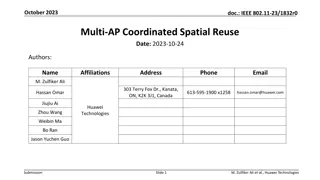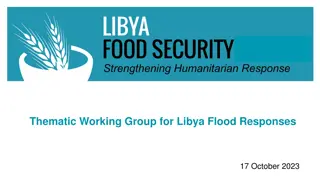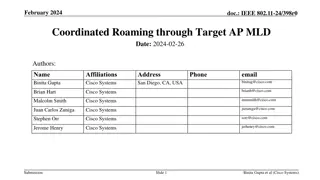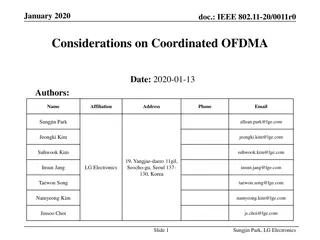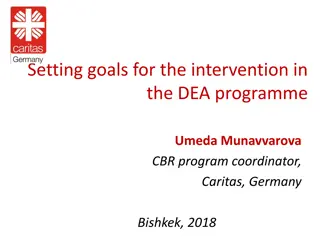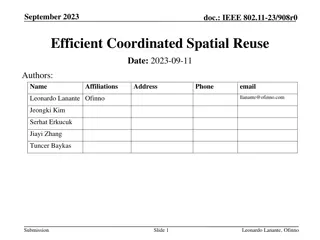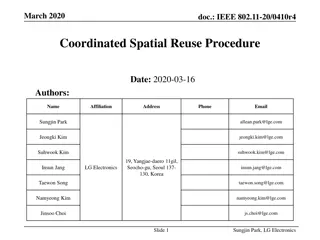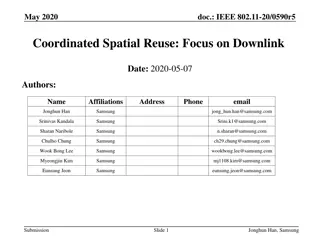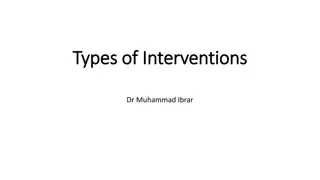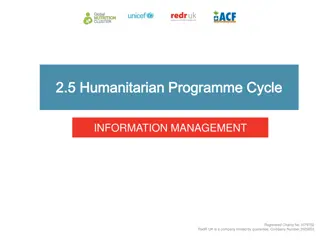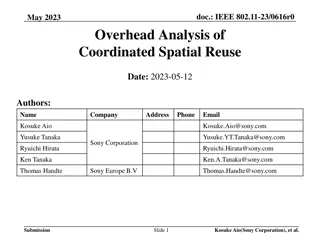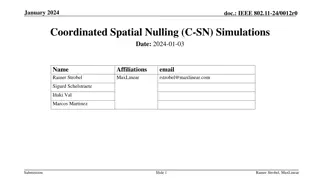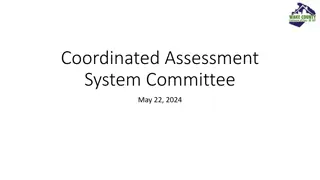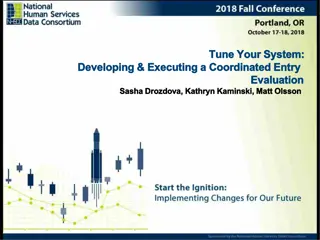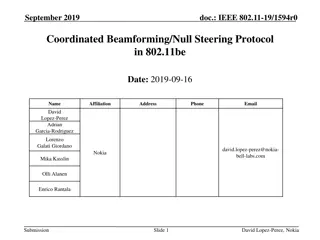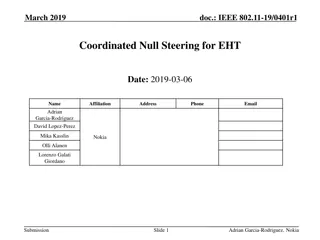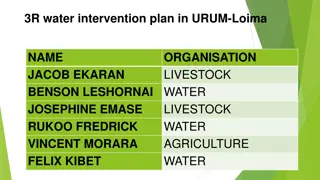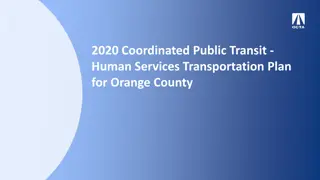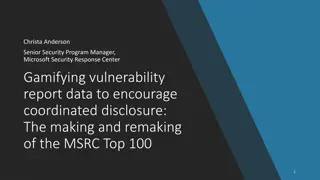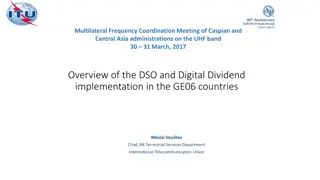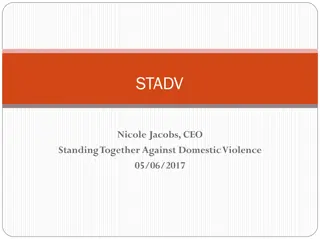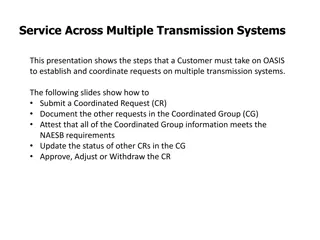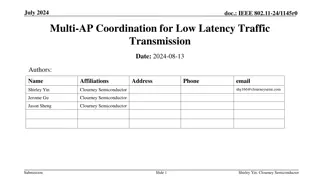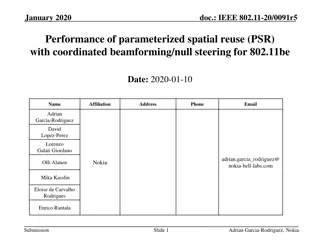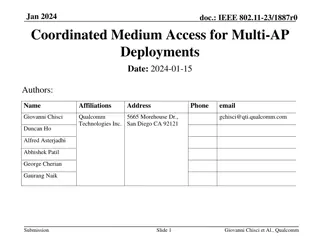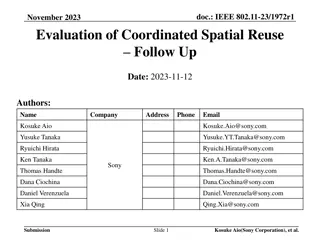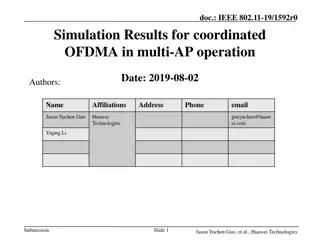Coordinated Spatial Reuse
Explore the concept of Coordinated Spatial Reuse (C-SR) in IEEE 802.11 networks, a scheme where multiple access points (APs) transmit data simultaneously to reduce interference and enhance resource utilization. Learn about the definition, benefits, and necessary components for successful C-SR operat
0 views • 15 slides
Coordinated Spatial Reuse in IEEE 802.11bn Standard
This contribution explores Coordinated Spatial Reuse (Co-SR) as a potential multi-AP feature for the IEEE 802.11bn standard. It discusses the trade-offs, proposes a method for downlink channel access, and evaluates its impact on goodput and packet delivery delay. The background highlights the gains
1 views • 17 slides
Understanding Coordinated Beamforming and MU-MIMO in IEEE 802.11-23/1998r0
This document delves into the intricacies of Coordinated Beamforming (Co-BF) and MU-MIMO techniques in the context of IEEE 802.11-23/1998r0 standard. It explores the concept of nulling in Co-BF, handling more Rx antennas than streams, Zero-Forcing precoding to eliminate Multi-User Interference (MUI)
2 views • 22 slides
Analysis of Power Control for Coordinated Spatial Reuse in IEEE 802.11-24
Evaluation of power control schemes for Coordinated Spatial Reuse (CSR) in IEEE 802.11-24, comparing benefits with and without power control. Results show gains in throughput and SINR with different CSR schemes and considerations for shared access points. Concerns and insights shared on the effectiv
6 views • 24 slides
Gain Analysis for Coordinated AP Transmissions in IEEE Enterprise R3 Network
This document discusses gain analysis results for coordinated AP transmissions in the IEEE Enterprise R3 network, focusing on tail latency gain for aperiodic traffic. Simulation setups, topology details, and results for different coordination schemes (C-TDMA, C-RTWT, and combined) are provided, show
5 views • 6 slides
Thematic Working Group for Libya Flood Responses - Updates and Coordination Efforts
Thematic Working Group for Libya Flood Responses held a meeting on 17 October 2023 to discuss coordinated responses, targeting needs and damage assessments. Updates and documents published by partners after 10 October 2023 were shared, including reports from SRSG Abdoulaye Bathily and various agenci
0 views • 10 slides
Coordinated Roaming Proposal for IEEE 802.11 Networks
This document presents a proposal for coordinated roaming through target AP MLD in IEEE 802.11 networks to address connectivity disruptions due to sudden RSSI drops or STA transition scenarios. The solution aims to ensure data continuity, preserve context, and minimize data loss during roaming hando
0 views • 11 slides
Understanding Coordinated Entry System (CES) in Homeless Services
Coordinated Entry is a strategic approach focusing on housing and service coordination to link individuals experiencing homelessness to appropriate resources. With a primary goal of quick identification and prevention of homelessness, the system assesses consumer needs and connects them to housing a
0 views • 12 slides
Coordinated AP Time/Frequency Sharing in IEEE 802.11be
The document discusses Coordinated AP (CAP) Time/Frequency Sharing in Transmit Opportunity in IEEE 802.11be, focusing on Frequency and Time resource sharing between multiple APs in close proximity. It introduces concepts like CAP OFDMA and CAP TDMA, outlining the benefits in terms of latency improve
0 views • 15 slides
Considerations on Coordinated OFDMA Operation in IEEE 802.11
The document discusses the Coordinated OFDMA (C-OFDMA) operation as a part of Multi-AP coordination schemes within the IEEE 802.11 standard. It covers resource allocation options, topology considerations, resource allocation methods, capability announcement procedures, and negotiation processes betw
0 views • 15 slides
Understanding Multi-AP Operation in IEEE 802.11-20-0617/r3
Explore the basic definitions and key features of Multi-AP operation in the IEEE 802.11 standard. Learn about Multi-AP Candidate Set (M-AP-CS) and Multi-AP Operation Set (M-AP-OS) along with their participants and formation. Delve into the concepts of Coordinator AP, Coordinated AP(s), and reliable
0 views • 19 slides
Intervention Boosting Self-Efficacy Among Adolescents Challenging Discrimination
Adolescents challenging discrimination through a perspective-taking and action-planning intervention showed increased self-efficacy, particularly among White participants. The intervention, which included facilitated discussion sessions, led to positive outcomes and highlighted the importance of bys
0 views • 7 slides
Boosting Self-Efficacy in Adolescents: Intervention Study
Adolescents challenged discrimination through a perspective-taking and action-planning intervention, leading to increased self-efficacy, especially among White participants. The intervention involved facilitated discussions, self-disclosure, and sharing experiences to empower adolescents to interven
0 views • 7 slides
Effective Intervention Planning for Rehabilitation Services
The intervention in the DEA programme involves a thorough assessment of user needs, formulation of objectives, and planning based on case management technology. The cycle includes assessment, planning, and actual intervention. Prioritizing high-priority problems is essential for effective outcomes.
1 views • 13 slides
Efficient Coordinated Spatial Reuse in IEEE 802.11-23
Coordinated Spatial Reuse (C-SR) is a Multi-AP transmission technique proposed for UHR networks that enhances efficiency by utilizing RSSI or pathloss feedback instead of complete CSI. This document introduces an efficient protocol for C-SR, focusing on a unified approach for better implementation.
0 views • 10 slides
Understanding IEEE 802.11-20/0410r4 Coordinated Spatial Reuse Procedure
This document presents the Coordinated Spatial Reuse (CSR) procedure in IEEE 802.11-20/0410r4, focusing on the transmission schemes and necessary information for effective spatial reuse. It outlines the topology of CSR environments, acquisition of information for CSR, CSR capability announcement by
8 views • 23 slides
Coordinated AP Time/Frequency Sharing in IEEE 802.11be
The document discusses the concept of Coordinated AP (CAP) Time/Frequency Sharing within a Transmit Opportunity (TXOP) in the IEEE 802.11be standard. It explains the procedures of Frequency and Time resource sharing, highlighting the benefits such as latency improvement and throughput fairness. Deta
0 views • 16 slides
Coordinated Spatial Reuse in IEEE 802.11 Networks
The document discusses Coordinated Spatial Reuse (C-SR) in IEEE 802.11 networks, focusing on downlink transmission. C-SR is a multi-AP coordination scheme aimed at enhancing spectrum efficiency by reusing time/frequency resources among multiple Basic Service Sets (BSSs). The procedure is divided int
1 views • 24 slides
Different Types of Interventions to Address Addiction Challenges
Every individual's addiction story is unique, requiring different types of interventions tailored to their specific needs. This article explores four popular intervention approaches - simple intervention, classical intervention, family system intervention, and crisis intervention - each designed to
1 views • 7 slides
Contrasting Parkinson's Pathways: Sub-optimal vs Optimal
Sarah's journey with Parkinson's illustrates the stark difference between a sub-optimal pathway leading to distress and a well-coordinated optimal pathway resulting in a peaceful end at home. Timely diagnosis, specialized support, coordinated care, and proactive interventions played key roles in Sar
1 views • 8 slides
Understanding the Humanitarian Programme Cycle (HPC)
The Humanitarian Programme Cycle (HPC) is a coordinated series of actions aimed at preparing for, managing, and delivering humanitarian responses efficiently. It focuses on delivering fast, coordinated, effective, and protection-driven aid to those affected by crises. Central to the HPC is the invol
2 views • 8 slides
Overhead Analysis of Coordinated Spatial Reuse in IEEE 802.11-23
Analysis of overhead components impacting the performance of Coordinated Spatial Reuse (Co-SR) in IEEE 802.11-23 standard for wireless communication. Evaluation of MAC overhead, negotiation and measurement phases, and frames in the negotiation phase. Discussion on the impact of overhead on Co-SR per
0 views • 14 slides
Proposal for IEEE 802.11-23/1984r1 TGbi Coordinated MAC Rotation
The document discusses a proposal for IEEE 802.11-23/1984r1 TGbi focusing on coordinated MAC rotation, EDP epochs, anonymity sets, and group epochs. It introduces concepts like individual and mass rotations, anonymity set size, and hiding in the crowd examples. The coordination for group epochs and
1 views • 10 slides
Coordinated Spatial Nulling (C-SN) Simulations in IEEE 802.11-24/0012r0
The document discusses the concept of Coordinated Spatial Nulling (C-SN) in IEEE 802.11-24/0012r0, focusing on spatial nulling feedback, synchronization needs, advantages of partial nulling, and comparison of half-coordinated versus fully coordinated scenarios. Simulation results are presented, anal
0 views • 19 slides
Coordinated Assessment System Committee Meeting Overview
The Coordinated Assessment System Committee convened on May 22, 2024, with a focus on various agenda items including HUD technical assistance updates, governance board information, and policies and procedures review. The committee discussed the submission of technical assistance requests to HUD, pot
0 views • 10 slides
Evaluating and Improving Coordinated Entry Systems
Community should regularly evaluate their coordinated entry systems to ensure proper functioning and identify necessary refinements for continuous improvement. Evaluation helps in maintaining effectiveness and efficiency of the system, benefiting all stakeholders involved in the process.
0 views • 27 slides
Coordinated Beamforming/Null Steering Protocol in IEEE 802.11be
Coordinated beamforming/null steering is a promising scheme in IEEE 802.11be for joint transmission/reception challenges. This protocol aims to efficiently realize gains by establishing semi-static inter-AP coordination, enhancing spatial reuse opportunities, implementing CSI acquisition, and managi
0 views • 15 slides
Coordinated Null Steering for Enhanced Wireless Communication
Null steering in wireless technology allows devices to place spatial radiation nulls towards non-served STAs for interference suppression, improving spatial reuse and mitigating inter-cell interference. This document discusses null steering-related proposals in EHT, including challenges, benefits, a
0 views • 16 slides
Water Intervention Plan in Urum-Loima Region
This water intervention plan in the Urum-Loima region focuses on addressing water gaps and potential zones for groundwater exploration. It includes related interventions such as open water storage and sand dams to meet current and future water demands for domestic, livestock, and agricultural use. T
0 views • 9 slides
Orange County Coordinated Public Transit & Human Services Plan 2020
The Orange County Transportation Authority (OCTA) has developed a Coordinated Public Transit & Human Services Plan that must be updated every four years. The plan includes assessments of available transportation services and needs, strategies to address gaps, and priorities for implementation. Objec
0 views • 13 slides
Gamifying Vulnerability Reporting for Coordinated Disclosure at Microsoft Security Response Center
Christa Anderson, a Senior Security Program Manager at Microsoft's Security Response Center, discusses the importance of gamifying vulnerability report data to encourage coordinated disclosure. The MSRC Top 100, announced at Black Hat USA, plays a crucial role in the public credit strategy by recogn
0 views • 13 slides
Overview of Multilateral Frequency Coordination Meeting for Digital Dividend Implementation
The Multilateral Frequency Coordination Meeting discussed progress in implementing digital switchover and digital dividend in the GE06 countries. It highlighted the allocation of spectrum for mobile services and the importance of coordinated implementation. Various coordination groups in Region 1 wo
0 views • 14 slides
Understanding Coordinated Community Responses to Domestic Violence
STADV, led by CEO Nicole Jacobs, focuses on domestic violence prevention. The organization's history, key figures, and innovations in coordination are discussed. The concept of Coordinated Community Response (CCR) is explained in depth, emphasizing the importance of agencies working together to supp
0 views • 21 slides
IEEE 802.11-23/1984r3 TGbi Proposal for Coordinated MAC Rotation
The document discusses a proposal for coordinated MAC rotation within the IEEE 802.11-23/1984r3 framework. It delves into concepts like Epochs and Coordination, Anonymity Set Size, and Hiding in the Crowd examples. The focus is on enhancing privacy and security through group and individual rotations
0 views • 11 slides
Coordinated Request Process on OASIS for Multiple Transmission Systems
This presentation guides customers on using OASIS to establish and coordinate requests on multiple transmission systems. It covers steps such as submitting a Coordinated Request (CR), documenting requests, attesting to NAESB requirements, updating statuses, and approving or adjusting requests within
0 views • 9 slides
Multi-AP Coordination for Low Latency Traffic Transmission
The document discusses the integration of multi-access point (AP) coordination to enhance the transmission of low-latency traffic in wireless networks. It addresses the challenges and introduces modes of operation capable of reducing latency and improving reliability for low-latency (LL) traffic tra
0 views • 9 slides
Performance Evaluation of Parameterized Spatial Reuse with Coordinated Beamforming for IEEE 802.11be
The study focuses on assessing the performance of parameterized spatial reuse (PSR) with coordinated beamforming/null steering for IEEE 802.11be. The framework allows coordinated sharing of uplink transmission opportunities among APs, demonstrating gains in synchronous coordinated beamforming system
0 views • 19 slides
Coordinated Medium Access for Multi-AP Deployments in IEEE 802.11 Networks
The document discusses a solution to reduce latency, increase throughput, and improve reliability in networks with latency-sensitive traffic by introducing coordination between access points (APs). This involves leveraging mechanisms like Restricted TWT (rTWT) and Coordinated rTWT (C-rTWT) to facili
0 views • 12 slides
Evaluation of Coordinated Spatial Reuse in Multi-AP Scenarios for IEEE 802.11-23/1972r1
Evaluation of Coordinated Spatial Reuse (SR) in a 4AP scenario for IEEE 802.11-23/1972r1 in November 2023. The study focuses on improving throughput in multiple BSS environments through coordinated SR. The simulation parameters include AWGN channel, pathloss exponent, noise figure, and other key fac
0 views • 15 slides
Simulation Results for Coordinated OFDMA in Multi-AP Operation
Multi-AP operation, specifically Coordinated OFDMA, is evaluated through system-level simulation results in a two-BSS scenario. The performance metrics include burst throughput and delay in a burst traffic model. Transmission procedure involves two APs sharing 160MHz bandwidth. The study aims to sho
0 views • 9 slides

